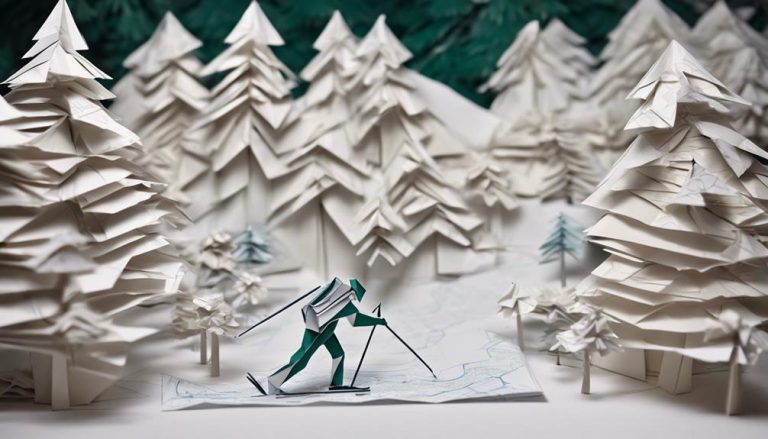General Rules of Snowshoeing
So, you've decided to venture into the winter wonderland on snowshoes, thinking it's just like strolling through the park. But hold on, before you start dreaming of picturesque trails and serene landscapes, there are a few essential rules you need to be aware of. From selecting the right gear to understanding the unspoken etiquettes of snowshoeing, there's more to this activity than meets the eye. Stay tuned to uncover the key insights that will make your snowshoeing experience both safe and enjoyable.
Choosing the Right Snowshoes
When gearing up for snowshoeing adventures, selecting the appropriate snowshoes is essential for a comfortable and enjoyable experience. Snowshoe sizing plays a crucial role in how well you can move across various terrains. Make sure to check the manufacturer's guidelines to find the right size based on your weight, as this affects weight distribution and prevents you from sinking into the snow. Additionally, consider the terrain suitability of the snowshoes; some are better for flat, packed trails while others excel in deep powder or steep slopes.
To enhance your snowshoeing experience further, pay attention to traction options. Snowshoes with aggressive crampons are ideal for icy or hard-packed snow, providing excellent grip and stability. If you often encounter mixed terrain, look for models with interchangeable traction systems for versatility. By choosing the right snowshoes that match your weight, terrain preferences, and traction needs, you can confidently stride through winter landscapes with ease and joy.
Dressing for the Winter Conditions
Hey there, snowshoer! When it comes to hitting the snowy trails, dressing appropriately is key to enjoying a safe and comfortable adventure. Layering up for warmth and choosing the right footwear are crucial aspects to consider before strapping on those snowshoes and heading out into the winter wonderland. So, let's chat about how to dress effectively for the chilly conditions so you can make the most of your snowshoeing experience!
Layering for Warmth
Ensuring proper layering is essential for staying warm and comfortable in winter conditions while snowshoeing. Here are four key items to consider for layering effectively:
- Base Layering: Start with a moisture-wicking base layer to keep sweat away from your body.
- Insulation: Add an insulating layer to trap heat and keep you warm in cold temperatures.
- Wind Protection: Choose outer layers that shield you from biting winds to prevent heat loss.
- Moisture Wicking: Opt for clothing that wicks moisture away from your skin to keep you dry and comfortable throughout your snowshoeing adventure.
Proper layering not only keeps you warm but also allows for easy temperature regulation, ensuring an enjoyable and liberating experience in the winter wonderland.
Proper Footwear Selection
Choosing the right footwear is crucial for braving the winter conditions while snowshoeing and ensuring a comfortable and safe adventure. Insulated boots are essential to keep your feet warm, while traction devices provide grip on icy terrain. Pair these with waterproof socks and proper gaiters to keep moisture out. Ensure your snowshoe bindings fit securely, and consider heel lifts for steep ascents. Check for technical features like adjustable straps and sizing charts to get the proper fit. Be mindful of weight capacity and terrain suitability when selecting your gear. Don't forget safety equipment, visibility gear, emergency shelter, a first aid kit, emergency contacts, and navigation tools. Prioritize wildlife awareness, group dynamics, trail etiquette, and nature appreciation for a fulfilling snowshoeing experience.
Staying on Designated Trails
To fully enjoy your snowshoeing experience, it is essential to stick to the designated trails. Following trail etiquette and respecting wildlife encounters are crucial aspects of responsible snowshoeing. Here are some key points to keep in mind:
- Preserving Nature: Staying on designated trails helps protect fragile ecosystems and prevents unnecessary harm to plant life.
- Safety First: Venturing off-trail can lead to getting lost or encountering hazardous terrain, so stick to the marked paths for your own safety.
- Respect Wildlife: By staying on designated trails, you minimize the disturbance to wildlife habitats and reduce the chances of unexpected encounters.
- Community Harmony: Following trail guidelines ensures a positive experience for all outdoor enthusiasts and helps maintain a harmonious relationship with fellow snowshoers.
Practicing Leave No Trace Principles
When snowshoeing, always prioritize practicing Leave No Trace principles to minimize your impact on the environment and preserve the beauty of the wilderness. Snowshoeing etiquette is crucial in ensuring the winter wilderness remains unspoiled for future adventurers. As you venture into the snowy expanse, remember to stay on designated trails to avoid trampling on delicate vegetation or disturbing wildlife habitats. Always pack out what you pack in, leaving no garbage behind. Whether it's a simple energy bar wrapper or a broken snowshoe binding, make sure you carry everything back with you.
Respect the tranquility of the winter wilderness by keeping noise to a minimum and refraining from playing loud music that disrupts the natural soundscape. When encountering other snowshoers or wildlife, maintain a respectful distance to allow them their space. By following these simple guidelines, you contribute to the preservation of these pristine landscapes, ensuring that they remain unspoiled for all to enjoy. Let's strive to leave only footprints and take only memories as we explore the wonders of the winter wilderness.
Being Prepared for Emergencies
Now, let's talk about the crucial aspect of being prepared for emergencies while snowshoeing. You need to have an emergency supplies checklist to ensure you're equipped to handle unexpected situations. Establish a communication plan with your group and familiarize yourself with local resources, such as nearby ranger stations or emergency services.
Emergency Supplies Checklist
During your snowshoeing adventures, ensuring you have an emergency supplies checklist can be a lifesaver in unexpected situations. Being prepared is key to a safe and enjoyable journey. Here are four essential items to include in your emergency kit:
- First Aid Kit: A compact kit with essentials like bandages, antiseptic wipes, and pain relievers can be a game-changer in case of injuries.
- Emergency Blanket: Stay warm and prevent hypothermia with a lightweight, reflective emergency blanket.
- Whistle: A loud whistle can help you alert others in case of an emergency or if you're lost.
- Flashlight: A reliable flashlight with extra batteries will guide you in the dark and help rescuers spot you easily.
Prepare, pack, and stay safe out there!
Communication Plan With Group
Ensure your group has a solid communication plan in place to stay connected and coordinated during emergencies while out snowshoeing. Effective group communication and established safety protocols are essential for a safe and enjoyable adventure. By having a clear plan, you can swiftly respond to any unforeseen situations that may arise. Here is a simple table to guide you on developing your communication plan with your group:
| Communication Method | Emergency Contact | Frequency of Check-ins |
|---|---|---|
| Walkie-Talkies | Local Authorities | Every 30 minutes |
| Whistles | Family/Friends | Every hour |
| Hand Signals | Park Rangers | At each trail junction |
Knowledge of Local Resources
In preparing for emergencies while snowshoeing, familiarity with local resources is crucial for ensuring a safe and well-equipped expedition. To be fully prepared for any unexpected situations, consider the following:
- Local Guides: Seek advice from experienced locals who know the area well and can provide valuable insights on potential risks and safety measures.
- Trail Maps: Always carry detailed trail maps to navigate your way efficiently and have a clear understanding of the terrain you will be traversing.
- Emergency Contacts: Keep a list of emergency contacts handy, including local rescue services and park rangers, for quick assistance if needed.
- Weather Updates: Stay informed about weather conditions by checking local forecasts before heading out, ensuring you are aware of any upcoming changes that may impact your journey.
Understanding Snowshoeing Etiquette
Navigating through the snow-covered wilderness on your snowshoes requires a deep respect for the environment and fellow outdoor enthusiasts. When it comes to snowshoeing etiquette and trail courtesy, it's crucial to follow some basic guidelines to ensure a harmonious experience for everyone sharing the trails. Check out the table below for a quick reference on proper snowshoeing etiquette:
| Snowshoeing Etiquette | Trail Courtesy |
|---|---|
| Stay on designated trails | Yield to other trail users |
| Leave no trace – pack out all trash | Keep noise levels to a minimum |
| Respect wildlife and their habitats | Share the trail and be courteous to others |
Enjoying the Snowy Scenery
As you venture further into the snow-covered wilderness on your snowshoes, the beauty of the snowy scenery will captivate your senses and invigorate your soul. The winter wonderland around you offers a plethora of sights and experiences that will make your snowshoeing adventure truly unforgettable.
Here are some ways to enhance your enjoyment of the snowy scenery:
- Snowy Photography: Capture the breathtaking landscapes and unique frosty details with your camera or phone to create lasting memories of your snowshoeing journey.
- Winter Wildlife: Keep an eye out for signs of wildlife such as tracks in the snow or the occasional glimpse of a furry creature, adding an element of excitement to your expedition.
- Mountain Views: Take in the majestic views of snow-capped peaks that surround you, offering a sense of awe and inspiration as you trek through the winter wonderland.
- Frozen Lakes: Discover the serene beauty of frozen lakes glistening under the winter sun, creating a peaceful and reflective atmosphere that complements the tranquility of snowshoeing.
Frequently Asked Questions
Can I Snowshoe on Any Type of Snow, or Are There Certain Conditions That Are Not Safe for Snowshoeing?
You can snowshoe on various snow types, but safety is key. Be cautious in icy or avalanche-prone conditions. Ensure proper gear and knowledge. Consider terrain difficulty for an enjoyable experience. Embrace the snow!
Are There Any Specific Wildlife or Environmental Hazards to Be Aware of While Snowshoeing?
When snowshoeing, be wary of potential wildlife encounters. Respect their space and enjoy observing them from a distance. Watch out for environmental hazards like hidden ice or falling branches. Stay alert and embrace nature's wonders.
How Do I Know if a Trail Is Suitable for Snowshoeing, and Are There Any Restrictions I Should Be Aware Of?
To determine if a trail's good for snowshoeing, check trail conditions online or at the trailhead. Ensure you're equipped with snowshoe rentals. Be mindful of any restrictions like trail closures or designated snowshoe areas.
Are There Any Special Considerations for Snowshoeing at High Altitudes or in Extreme Weather Conditions?
When snowshoeing at high altitudes or in extreme weather, it's crucial to prioritize safety. Be prepared with proper gear like layers, hydration, and navigation tools. Stay informed on weather forecasts and heed warnings.
Are There Any Recommended Techniques for Navigating Steep or Challenging Terrain While Snowshoeing?
When navigating steep or challenging terrain while snowshoeing, it's crucial to use proper techniques. Maintain balance, take smaller steps, and use trekking poles for added stability. Always prioritize safety precautions to ensure a thrilling yet secure adventure.






